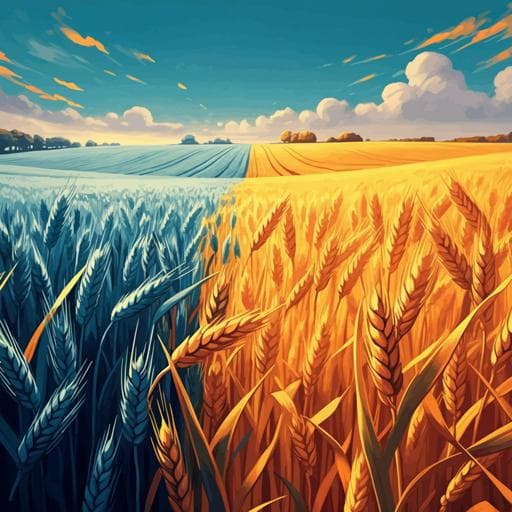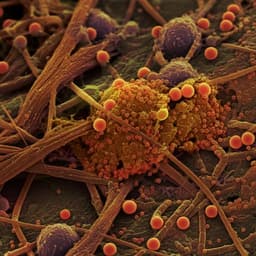
Agriculture
Effects of winter soil warming on crop biomass carbon loss from organic matter degradation
H. Ni, H. Hu, et al.
Discover how winter warming impacts crop biomass carbon, with a notable decrease linked to rising soil temperatures. This crucial research by Haowei Ni, Han Hu, Constantin M. Zohner, and colleagues emphasizes the importance of considering winter's effects on agricultural models to better adapt to climate change.
~3 min • Beginner • English
Introduction
Rapid global warming has already reduced crop yields and biomass, challenging the ability to meet rising food demand by 2050. Warming is most pronounced in winter, especially in northern mid- and high-latitudes, yet the specific effects of winter warming on crop biomass remain unclear. Winter warming can disrupt winter crops by breaking dormancy, advancing phenology, shortening growing seasons and photosynthetic activity, and increasing pests and diseases. Beyond direct plant effects, winter warming alters soil temperature and moisture, potentially accelerating soil organic matter (SOM) decomposition, changing nutrient availability, and thus influencing subsequent crop biomass even for non-winter crops. The study aims to quantify the effect of winter soil warming on crop biomass carbon (C) and elucidate soil-mediated mechanisms. The authors hypothesised that warmer winters reduce SOM and soil nutrient retention, decreasing crop biomass C, with stronger effects at mid-to-high latitudes.
Literature Review
Prior work has focused mainly on mean annual air temperature effects on crop yields, despite winter temperatures increasing ~1.8 times faster than annual means in many regions. Studies show winter warming can increase soil respiration and SOM decomposition by elevating soil temperature and altering moisture, with effects modulated by latitude and freeze–thaw cycles. Winter warming risks for winter crops include broken dormancy, advanced phenology, shortened seasons and photosynthesis, and more pests/pathogens. High-latitude systems experience frequent freeze–thaw cycles that can exacerbate SOM loss under warming. While effects on winter crops are better studied, impacts on non-winter crops via soil legacy processes remain underexplored. SOM is central to soil fertility, supporting moisture retention, nutrient availability, and root development. The literature supports a mechanistic pathway whereby winter warming accelerates SOM degradation, reduces micronutrient availability (e.g., Fe, Zn, Mn, Cu), and could thereby reduce crop biomass, particularly at higher latitudes.
Methodology
The study combined a global meta-analysis with decade-long field experiments across a latitudinal gradient. Global dataset: 309 straw C observations and 1358 grain C observations from 161 field sites compiled from peer-reviewed literature (to 31 Oct 2023) via Web of Science, Google Scholar, and CNKI. Inclusion criteria: in situ field data; control/fertiliser/undisturbed treatments; crops limited to maize, wheat, or rice; at least one full growth cycle; studies with inorganic/mineral fertilisers (organic fertiliser studies excluded). Grain C was derived from reported grain starch using Grain C (%) = Grain starch (%) × 72/162. Additional site variables (SOC, pH, macro-elements, texture, cation exchange capacity, soil moisture/temperature including winter soil temperature) were extracted or filled from global datasets (e.g., GLDAS, NASA, gridded Global Soil Dataset) at ~0.083° resolution; SOM was SOC × 1.724. Random forest models assessed the importance of 27 environmental variables; hierarchical partitioning quantified contributions of different temperature metrics; datasets were partitioned by latitude (>30° vs ≤30°) and by crop. Mixed-effects modelling: Linear mixed-effects models related crop biomass C (straw, grain) to winter soil temperature with climate and crop type as random effects on slopes and intercepts. To construct change metrics, inter-annual differences within the same climate zone were used due to limited long-term co-located time series. Model selection used AIC/BIC; bootstrapping (999 resamples) estimated confidence intervals; t-tests compared slopes; Shapiro–Wilk and ANOVA chi-squared assessed assumptions and model differences. Field experiments: Conducted at three Chinese Academy of Sciences stations spanning climates and latitudes: Hailun (47°26′ N; Mollisols; MAT 1.5 °C; MAP 550 mm), Fengqiu (35°00′ N; Inceptisols; MAT 13.9 °C; MAP 605 mm), Yingtan (28°15′ N; Ultisols; MAT 17.6 °C; MAP 1795 mm). In October 2005, in situ experimental blocks (1.4 × 1.2 × 1.0 m) were established with isolation (brick walls, quartz sand base, tarpaulin). Soil profiles were excavated in 20-cm layers and reassembled. To simulate accelerated SOM loss, Mollisols from Hailun were translocated to Fengqiu (Trans1) and Yingtan (Trans2), while in situ local soils were maintained at each site. Maize was grown annually from 2006 under regular inorganic fertilisation (150 kg N ha−1, 75 kg P ha−1, 60 kg K ha−1; urea, (NH4)2HPO4, KCl). Half the N applied pre-plant, half at large trumpet stage. Three biological replicates per treatment. Sampling: Annually (2006–2015) post-harvest, three composite soil samples (0–20 cm; five cores per block) and three plant samples per site were collected for in situ plots (total 90 plants and 90 soils over 10 years). For translocated plots at Fengqiu and Yingtan, 60 plant and 60 soil samples over 10 years were collected. Straw and grain were dried (70 °C), ground, and analysed for C by dry combustion (elemental analyser), with calibration every 20 samples and triplicate analyses. Soil measurements: Winter soil temperature and moisture (0–20 cm) monitored; pH (1:2.5 soil:water); SOC by dichromate oxidation; SOM by van Bemmelen factor (1.724). Minerals/micronutrients: Fe and Al phases extracted by sodium pyrophosphate and ammonium oxalate (Fep, Alp, Feo, Alo) quantified by ICP-MS; available Fe, Mn, Cu, Zn extracted by DTPA and measured by atomic absorption. Enzyme assays: α- and β-glucosidase using 4-methylumbelliferone substrates; incubated 3 h at 25 °C; fluorescence corrected for quenching. Microbial community: DNA extraction (MoBio PowerSoil with freeze–thaw), 16S rRNA V4 and 18S rRNA V9 two-step PCR (10 + 15 cycles), Illumina MiSeq 2×250 bp; quality filtering and ASV inference (UNOISE3). Statistical analyses: Random forest (randomForest R package), hierarchical partitioning (glmm.hp), linear/nonlinear and mixed-effects models (stats, minpack.lm, nlme), model selection via AIC/BIC, residual normality (Shapiro–Wilk), ANOVA chi-squared test, bootstrapping (999 resamples), Tukey’s post-hoc and Duncan’s tests for comparisons. Structural equation modelling (SEM) assessed direct/indirect effects of winter soil temperature, mineral protection (Fe/Al forms), SOM, moisture, pH, micronutrients (available Fe:Zn ratio), microbial diversity (Shannon H′ for prokaryotes and eukaryotes), and hydrolase activity (α-1,4- and β-1,4-glucosidase) on crop biomass C; model fit assessed by χ2/df, P, CFI. Projections: Total crop C defined as crop yield × biomass C content, computed separately for straw and grain using actual observed C contents versus previously assumed stable contents (~40% straw, ~42% grain). Linear regressions over the decade estimated changes relative to year 1; projected loss (%) computed as the difference between actual and previously estimated decade changes divided by decade-average actual total crop C.
Key Findings
- Global meta-analysis and field experiments revealed a robust negative relationship between winter soil temperature and crop biomass C. Across crop types and climates, each 1 °C increase in winter soil temperature decreased straw C by 6.62 ± 1.65 g kg−1 and grain C by 10.21 ± 2.31 g kg−1 (P < 0.05), with maize and rice showing stronger declines than wheat.
- The negative relationships held across fertilisation treatments and were stronger at mid-to-high latitudes than at low latitudes (P < 0.05).
- Random forest analyses identified temperature as the dominant predictor of crop biomass C, with SOM as a key secondary factor; soil moisture also contributed notably.
- Soil translocation experiment (Hailun Mollisols moved to Fengqiu and Yingtan) showed accelerated SOM decline rates relative to local soils: 0.97 and 1.13 g kg−1 per °C for translocated soils vs 0.47 and 0.26 g kg−1 per °C in local soils. Correspondingly, declines in straw and grain C were steeper in translocated soils (P < 0.05).
- SEM indicated that interactions among winter soil temperature, soil geochemistry, and microbial characteristics explained 80% of crop biomass C variability at high latitude, 42% at mid-latitude, and 44% at low latitude. Higher winter soil temperatures reduced mineral activity and mineral protection, decreased SOM, and lowered micronutrient availability (notably Fe:Zn), thereby reducing crop biomass C. Effects of soil moisture differed by latitude due to freeze–thaw dynamics.
- High-latitude regions experienced greater SOM loss per °C of winter soil warming (0.9 g kg−1 °C−1), about 1.5× mid-latitudes and 1.7× low latitudes.
- Winter soil temperatures averaged 1.4 °C higher than corresponding air temperatures, indicating soil acts as an amplifier of air temperature changes.
- Incorporating winter soil warming effects suggests previous projections overestimate total crop production; projected decreases in total crop C over a decade range from 4% to 19% overall, with 8% to 19% in mid-to-high latitude regions.
Discussion
The findings directly address the research question by demonstrating that winter soil warming reduces crop biomass C via soil-mediated mechanisms. Elevated winter soil temperatures diminish mineral-associated protection of SOM and stimulate microbial activity and extracellular enzymes, accelerating SOM degradation. The consequent depletion of SOM reduces the availability of essential micronutrients (Fe, Zn, Mn, Cu) that support plant carbohydrate synthesis and growth, leading to lower straw and grain C contents. These processes create a legacy effect whereby winter conditions influence subsequent growing seasons, even for non-winter crops. The impacts are strongest at high latitudes due to frequent freeze–thaw cycles that exacerbate SOM and nutrient losses under warming. The distinction between soil and air temperature is critical; soil temperatures exceed air temperatures in winter, and moisture interactions in the root zone further modulate plant responses, underscoring the need to incorporate soil thermal and moisture regimes into crop projections. Overall, neglecting winter soil warming leads to overestimation of agricultural productivity and underestimation of SOM losses, with implications for food security and the global carbon cycle.
Conclusion
This study provides global-scale and experimental evidence that winter soil warming significantly reduces crop biomass carbon through accelerated SOM degradation and micronutrient depletion, with the strongest effects at mid-to-high latitudes. It quantifies declines in straw and grain C per degree of winter soil warming and demonstrates mechanistic pathways via reduced mineral protection, altered microbial and enzymatic activity, and nutrient losses. Projections indicate that ignoring winter soil warming can overestimate total crop C by 4% to 19%. Implications include the need to integrate winter soil temperature and soil depth–resolved thermal and moisture dynamics into crop and food security models. Future work should: (1) incorporate soil temperature–moisture profiles in yield projections; (2) expand experimental validation across soil types and crop varieties; (3) evaluate management strategies (e.g., organic amendments, residue retention, micronutrient management) to mitigate SOM and nutrient losses; (4) breed crop varieties with enhanced photosynthetic efficiency and resilience to shortened seasons; and (5) assess broader impacts on soil carbon sequestration and greenhouse gas fluxes.
Limitations
- Field experiments were conducted at three sites in China and used one translocated soil type (Mollisols), which may limit generalisability across other soils and regions.
- Only inorganic fertiliser treatments were included; the effects of organic fertilisers and residue management, which can directly affect SOM, were not tested.
- Grain carbon content in the meta-analysis was often inferred from starch content using a conversion factor, potentially introducing uncertainty where protein and lipid contents vary.
- Winter soil temperature and moisture measurements focused on the 0–20 cm layer; deeper soil dynamics were not explicitly resolved.
- Global analyses relied on inter-annual differences within climate zones due to limited long-term co-located time series, which may not fully capture site-specific temporal variability.
- Potential confounding from varying soil types, management histories, and cultivar differences across global datasets cannot be entirely excluded despite mixed-effects controls.
Related Publications
Explore these studies to deepen your understanding of the subject.







